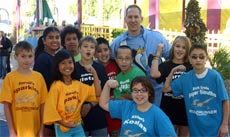Life-ready / Whole-Child Education
Two long-term crises in the USA demonstrate how our educational systems are not preparing our children for success in life. The first is the obesity, diabetes and chronic health conditions epidemics, and the second is the personal income crisis. Our citizens should have been better prepared.
We can do much better at addressing these disasters and preventing others in the future, by integrating life skills and habit education more comprehensively and effectively into our curricula. Schools can help empower our children with the preventive mental, physical and social intelligence they need to proactively make better career, financial, health, civic, and other decisions.
To achieve this, we must move beyond traditional life skills education approaches in four fundamental ways:
- Integrate life skills and habit education into the core curriculum. Life skills and habit development should be an important, applied component of the entire preK-12 instructional process. In turn, applied learning keeps students engaged in their learning. The potential synergies are compelling.
- Teach a more comprehensive set of skills and habits. Students should not just be college- and career-ready, but life-ready. This means that all students should also be finance-, citizen-, and health-ready.
- Change behaviors, don’t just provide knowledge. Unfortunately, knowledge alone often has little impact on financial, civic and health behaviors. Just as we insist that students learn critical thinking, not just facts, we should insist that life education improves students’ behaviors—what they actually do—not just their knowledge of what they should do.
- Measure behavior change and new habits. To make sure that good skills and habits are developing, we need to assess that. We have a number of ways of doing so, including physical fitness evaluations, physical activity tracking, and nutrition behavior surveys & reporting in the health arena. A whole-child report card for each school would be ideal.
- Follow-through school-based education with on-going reinforcement later in life. The most effective way to reinforce healthy behavior for adults may be behavioral economics-based approaches: provide financial incentives—including tax cuts, insurance premium discounts, and user fees—to behave more healthily, to update and apply personal financial skills, etc.
The Journal of the AMA reported in 2010 that two-thirds of adults and one-third of children in the US are overweight, and about half of overweight Americans are obese. What is more, by the time children reach adolescence, it is often too late: 80% of overweight teenagers become overweight adults. Early, effective, and sustained education on good nutrition and exercise habits are keys to solving this problem through prevention.
Yet we are not insisting that our schools be used to instill healthy habits, and we are not giving schools the resources to do so. As a result of not investing hundreds of millions of dollars per year in preventing diabetes, obesity and other preventable chronic health conditions through the school systems, researchers calculate that we are paying hundreds of billions annually in obesity-related and other chronic health care costs.
In addition to learning healthy behavior, our schools can educate our young citizens on how to find and keep a job, manage a household budget including the appropriate use of debt, live and work more effectively with others, become a better citizen, and other key life skills and behaviors.
By integrating life skills education into the standard curriculum, in a developmentally appropriate way, students also remain more engaged in learning—with less risk of dropping out. They now understand better the relevance of reading & English, math & science, and social studies to their personal lives, as these subjects are connected with personal finance, civics, health and physical education.
What is more, among middle school students, PE is often the most popular subject, and in high school, sports participation is the most effective extracurricular activity for student retention.
On the personal income front, there has been increasing focus on stagnant household income for lower- and middle-income Americans. Being life-ready will help Americans increase their income, and make better use of what they earn.
But the personal income crisis is much more pernicious than stagnating real wages. In particular, rising health costs are seriously undermining employer profits and employee disposable income. Employers pay more for their employees’ health insurance, and have less money to increase wages. In addition, employers are asking employees to pay a bigger share of health insurance costs—higher premiums and higher deductibles.
The Bureau of Labor Statistics reports that, for the middle 60% of Americans by income, non-inflation-adjusted income increased by only 0.2% from 2007 to 2014, while health care costs increase over 24% and health insurance premiums increased over 42%. This trend will continue, with the Council of Economic Advisers predicting that average per capita compensation, net of inflation and health insurance costs, will not increase for the foreseeable future.
At the same time, higher health costs are not making us healthier. Indeed, Americans’ health is worse, across a range of indicators, including life expectancy, than in many European countries with much lower per capita health spending.
Preventable chronic health conditions are the primary cause of increasing health costs. The behaviors at the root of these conditions are lack of exercise, unhealthy nutrition, smoking, and excess drinking, in addition to genetics, stress, and age. Yet adult Americans and the traditional health care system struggle to change our behavior.
For the sake of both health and income, we need to redefine the health care system to include schools and behavioral economics. We need to increasingly see our education, health, social services, food, tax, insurance and other systems as interdependent—and develop integrated cross-sector solutions.
Healthy Future US will work with other organizations to integrate life skills and behavior education into American schools. We will also work to reinforce healthy behavior later in life through tax and insurance health incentives and other policies for each person’s lifelong learning and success.
(Please see our latest slide deck for more details, as well as this list of research evidence references.)


Operation Tone-Up’s Tony Lamka
with students
Edunuity Blog
Email List


